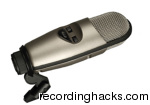CAD M177 Proves Its Value
Originally published at radioworld.com/reference-room/product_evaluation/ss-cad-June20.shtml
by Paul Kaminski
American-Born M177 Cardioid Condenser Mic Dispels the Theory That a Quality Means a Steep Price
Cardioid Condenser Microphone
Thumbs up:
- Clear, warm, quiet-sounding mic
- Easy mount
- Attractive, looks similar to RCA 77-DX
- Price
- Immune to computer monitor hum
Thumbs down:
- Like all condensers, increased sensitivity
- highlights acoustic problems in the studio
- Talent may have to change mic technique
- The suggested list price is $249.95
A quiet revolution has begun in the manufacturing of side-address condenser microphones.
Those looking for the clarity, warmth, tonal quality and low-noise figures of the condenser mic can get improved sound quality for less money. In fact, the $200 street price for some models is driving equipment replacement and upgrade decisions.
The American-made  CAD M177 cardioid condenser mic is a solid addition to this market segment and perhaps the best of the bunch.
CAD M177 cardioid condenser mic is a solid addition to this market segment and perhaps the best of the bunch.
Attractive mic
The M177 is a single-pattern, side-address condenser mic. It does not look like the typical Neumann imitator, but reminds us of the RCA 77-DX.
When asked if that was a design cue, C.P. Pores, national sales manager audio products group of CAD, said, "We’ll never apologize for making an attractive microphone."
Behind the business end of the mic, there is a 1.1-inch large gold-sputtered diaphragm.
That diaphragm — a version of the original Equitek 300 capsule — and op-amp circuitry instead of the typical field effect transistors (FETs) give the M177 a published frequency response of 10 Hz to 20 kHz, a dynamic range of 133 dB, an output level of 15.9 mV/Pascal and an equivalent SPL noise level of 10 dB A-weighted.
The unit requires phantom power of 24, 48 or 52 V with at least 8 mA for proper power. Even at this price, the microphone comes with its own frequency response plot. We found the response to be flat out to 2 kHz with a slight rise thereafter.
The microphone has a bass roll-off switch and a 20 dB pad on the front of the mic. CAD recommends you engage the pad before setting any mic preamp level. On our Mackie 1202 VLZ mixer, we followed instructions and got clean sound.
The channel gain was at the 2 o’clock position, which was the setting for our dynamic mic. We then disengaged the pad on the mic and began to set the channel gain for optimum output.
With the pad disengaged, we only needed to set the channel gain to 10 o’clock — or just a bit above the "U" unity gain setting on the 1202 VLZ. We suspect users with outboard preamps will have much the same result.
Don’t put that in your mouth
We had to change our mic technique for this test. No longer could we use the same technique used to enjoy New York City pushcart hot dogs.
I found I could get a warm, clear and authoritative sound if I kept my mouth four inches from the M177 business end. Any closer and the proximity effect and resulting plosives would be exaggerated. To bring back a little of that warmth, I raised the 80 Hz equalizer on the Mackie channel strip about one notch.
The polar pattern is more full on the right side of the mic between 0 and 60 degrees, so the sweet spot is more to the right. With the integral mount, you can swivel the mic so the sweet spot flatters your approach.
The M177 also solves another problem some small and large studio users encounter: negating hum from computer monitors.
Hum created by the CRT rides for free when dynamic microphones are positioned near the screen. With the channel gain turned up to maximum, and the mic channel open, we could not hear any noise from the computer monitor.
This feature makes a big difference when you are mastering digitally. It also works well on the most frequency-challenged medium of all — the POTS interview through a hybrid.
Our test period coincided with the Daytona 500 in February and the resultant controversy surrounding the death of Dale Earnhardt. The unit performed well, whether laying down voice tracks or doing two-way interviews over our POTS hybrid.
Good origins
The M177 is made in Conneaut, Ohio, near the shores of Lake Erie. What CAD learned in 12 years of making microphones — like the Equitek E-100, 200 and 300 — was important in the design, manufacturing and subsequent pricing of the M177.
The list price for the mic is $249.95. The street price is in the $200 category. The unit comes with a padded case, frequency plot and a two-year warranty.
"The design, quality and ability to assemble the product efficiently saved us a chunk of change," said Pores. Those savings are passed on to the consumer.
Given the innovative and efficient means of manufacturing the microphone, the introduction of the CAD M177 could be compared to the debut of the similarly well-thought-out Mackie 1202 and 1402 series mixing boards only a few years earlier.
American-built products bring professional results and quality to the value-priced segment of the equipment market. Since I am a charter member of the value-priced segment, I always like to solve a major-league problem with a minor-league expenditure.
Paul Kaminski is the news director of the Motor Sports Radio Network, and host of its "Race-Talk" and "Radio-Road-Test" programs.